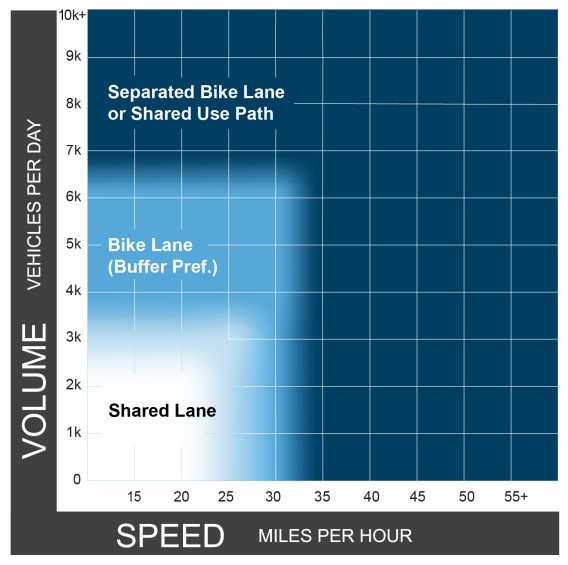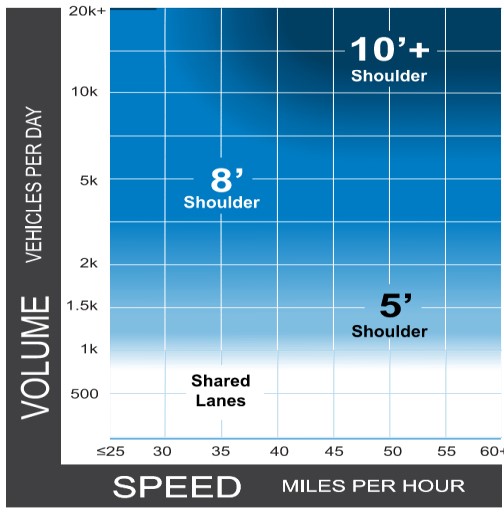18.2.4 General Bikeway Selection
The figures in this section provide some general guidance for the bicycle planning principles, target design user, and context discussed in the previous sections. Note, these Figures are for very general guidance and a preliminary bikeway recommendation.
provides specific design criteria and additional guidance for the application of bikeways to serve a target design user. In particular, elements associated with the respective roadway speed criteria discussed in the application discussion or each bikeway in
should be reviewed before making a final bikeway selection and choosing specific design elements. As long as the project meets the defined criteria in
for a specific bikeway,
the engineer has the discretion to select the bikeway that is best suited to the project needs and constraints.
provides an example selection process from FHWA. Note that
and
should be used to make the initial recommendation for the type of bicycle facility

Figure 18-2: FHWA Bikeway Selection Process and Guide Outline
18.2.4.1 Requirements for Selection – Urban, urban Core, Suburban, and Rural Town
For all urbanized (urban, urban core, suburban, and rural town) contexts, the following guidance is provided for various types of construction (the selection guidance is based primarily on
):
- For full reconstruction projects, new construction projects, or other construction projects whether in existing ROW or with additional ROW, the project should use for the initial recommendation for bikeway facility type. See for guidance on downgrading to the next best facility type. For the selected facility type, the geometric values should adhere to the specific guidance for that facility type. For values not provided in this guide, refer to the and, for separated bike lanes, and . Note: TAS/ requirements for each facility type must be met as well.
- For projects involving bridge replacement, bridge deck replacement, or bridge rehabilitation, the following guidance is provided:
- A 5-ft minimum clear space (4-ft shoulder and 1-ft offset measured to the toe of barrier) shall be provided on the structure and along the adjacent barrier. Off-System Bridges, with current ADT greater than 400 ADT, where this addition may represent an unreasonable increase in cost may be excepted from this requirement. See for specific off-system bridge requirements for current ADT of 400 or less. Where feasible, desirable shoulder width as shown in should be used. (This requirement is not applicable if an SUP or other bikeway is provided for bike accommodations.)
- For roadways identified on theTexas Bicycle Tourism Example Network, preferred 10-ft (minimum 8-ft) shoulder width should be provided on bridges. (This requirement is not applicable if an SUP or other bikeway is provided for bike accommodations.)

Figure 18-3: Recommended Bicycle Facility Selection for Urban, Urban Core, Suburban, and Rural Town Context
NOTE: Use the higher of the design speed and the posted speed for the speed. To be conservative when designing for all ages and abilities facilities, designers should attempt to use the higher-level facility at the respective boundary limits.
18.2.4.2 Requirements for Selection – Rural
For rural context (not rural towns), the below guidance is provided for various types of construction:
- For new construction, reconstruction, or widening projects in a rural setting where ROW is being acquired, the following guidance is provided:
- When the scoping process and environmental documentation indicates a need for bicyclist accommodations, the recommended bikeway is shown in , indicating the desirable shoulder widths for various speeds and traffic volumes. In some cases, a shared use path or other locally preferred facility type (such as a buffered bicycle lane or separated bicycle lane) may be identified during stakeholder outreach. See for additional guidance on shoulders and for shared lanes. See for guidance on downgrading to the next best facility type. Note: TAS/ADAAG requirements for each facility type must be met as well.
- Roadways indicated in should be designed with a minimum 8-ft shoulder, a shared use path, or another locally preferred facility type.
- Where new construction, reconstruction, or widening is accomplished without additional ROW, the above should be followed where feasible. See for guidance on downgrading to the next best facility type. Note: TAS/ADAAG requirements for each facility type must be met as well.
- For projects involving bridge replacement, bridge deck replacement, or bridge rehabilitation, the following guidance is provided:
- A 5-ft minimum bicycle clear space (4-ft shoulder and 1-ft offset measured to the toe of barrier) shall be provided on the structure and along the adjacent barrier. Off-system Bridges, with current ADT greater than 400 ADT, where this addition may represent an unreasonable increase in cost may be excepted from this requirement. See for specific off system bridge requirements for current ADT of 400 or less. Where feasible, desirable shoulder width as shown in should be used. (This requirement is not applicable if an SUP or other bikeway is provided for bike accommodations.)
- For roadways identified on theTexas Bicycle Tourism Trails Example Network, preferred 10-ft (minimum 8-ft) shoulder width should be provided on bridges. (This requirement is not applicable if an SUP or other bikeway is provided for bike accommodations.)

Figure 18-4: Recommended Bicycle Facility Selection for Rural Context
NOTE
: A separated shared use path is a suitable alternative to providing paved shoulders solely for the purpose of a bikeway and should be considered on Bicycle Tourism Trail Example Network segments as well as rural roads with ADT above 6000 vehicles per day. Use the higher of the design speed and the posted speed for the speed. If the percentage of heavy vehicles is greater than 5%, consider providing a wider shoulder or a separated path.